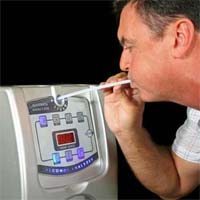A ‘Breath of Hope’ for Mesothelioma Diagnosis

A new report that analyzes the available data on breath testing for mesothelioma says the technique has great promise for detecting the disease earlier.
The study, entitled “Breath analysis in asbestos-related disorders: a review of the literature and potential future applications”, says many of the current invasive methods for diagnosing mesothelioma carry a high risk of complications, especially in the elderly, who are most likely to contract the disease. Mesothelioma is the most deadly of a group of asbestos-related disorders which also include asbestosis, pleural plaques, and lung cancer. Because the disease can take from 20 to 50 years to develop, most mesothelioma patients are over 65.
Mesothelioma surgery carries many risks, a fact that has prompted researchers around the world to search for ways to diagnose it earlier and give patients more treatment options. Among the newest non-invasive diagnostic methods being tested are those that detect tell-tale components in the exhaled breath of mesothelioma patients.
Inhaled asbestos fibers have been shown to cause inflammation, DNA damage and cellular death. The resulting oxidative damage triggers the production of reactive metabolites and reactive oxygen species, some of which can be detected in exhaled breath. Substances such as nitric oxide and certain volatile organic compounds are found in higher concentrations in people with asbestos-related conditions. Highly sensitive breath analyzer technology can detect these compounds in the condensed exhaled breath of people suspected of having mesothelioma.
Another newer technology aimed at detecting signs of mesothelioma in the breath is the electronic nose. This is a method of breath sampling that can be trained to recognize a wide range of odorant molecules and construct a ‘smellprint’ of chemical compounds that are indicative of a particular disease. More than 3,000 volatile organic compounds can be present in exhaled breath. Another team of researchers has been able to train a group of dogs to distinguish between the breath of subjects with lung and breast cancer with 99% accuracy.
The author of the analysis paper, Eleanor Chapman of the School of Medical Sciences in New South Wales, Australia concludes that “reports of high accuracy [of breath testing] in lung cancer discrimination and also in mesothelioma show promise for their application in easy detection of disease, monitoring of treatment and also in improving understanding of basic pathophysiology.”
Sources:
Chapman, Eleanor et al, “Breath analysis in asbestos-related disorders: a review of the literature and potential future applications”, September 2010, Journal of Breath Research.





